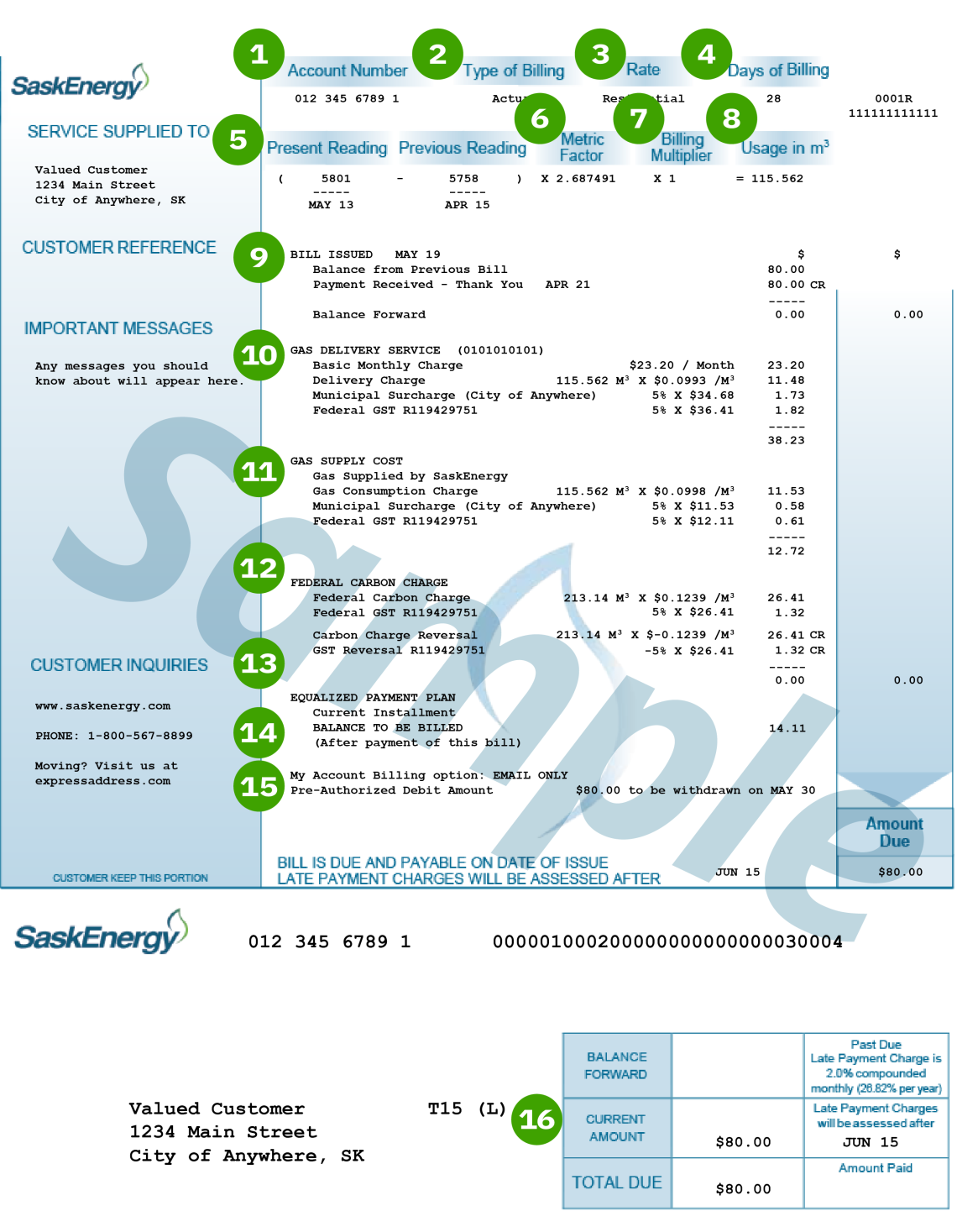How to read your bill
Your natural gas bill is more than an amount due. Find the answers you are looking for to commonly asked questions by taking a tour of a sample bill.

1. Account Number
An 11-digit number that can be used to request information about your account.
2. Type of Billing
Indicates if the gas consumption is from an actual meter read or an estimate.
Actual: SaskEnergy utilizes Advanced Metering Infrastructure (AMI) to automatically collect gas usage amounts for residential, farm, and business customers. In some instances, a manual meter read by a customer or field representative may be used.
Estimate: If we did not successfully receive a meter read, we estimate your bill amount based on the last two years of natural gas consumption, factoring in the weather during the billing period.
3. Rate
Identifies your rate class.
Residential: The rate to charge for customers consuming less than 10,000 m3 of natural gas annually.
Commercial Small: The rate to charge for customers consuming up to 100,000 m3 of natural gas annually.
Commercial Large: The rate to charge for customers consuming between 100,001 m3 and 660,000 m3 of natural gas annually.
Industrial: The rate to charge for industrial customers exceeding 660,000 m3 of natural gas annually.
4. Days of Billing
The number of days included on the bill and applied to your account.
5. Meter Readings
Present Reading: The meter read from the current month.
Previous Reading: The present reading that appeared on last month’s bill.
Consumption is calculated as the difference between the present and previous meter reads in hundreds of cubic feet.
6. Metric Factor
Includes a metric conversion calculation and a factor that recognizes elevation and atmospheric pressure specific to your service location.
7. Billing Multiplier
Accounts for the variation in average atmospheric pressure and the meter pressure. For residential meters, the temperature factor and billing multiplier are usually 1.
8. Usage in m3
Consumption on most gas meters is measured in hundreds of cubic feet (100cf). To convert to cubic meters (m3), we use a metric factor and multiplier. M3 is the same unit of measurement we use to apply delivery and commodity rate charges.
9. Bill Issued
Includes the amount from your previous bill and any payments we received since your last bill. The date on which your last payment was received also displays. The balance forward is the amount still owing and/or any payments or adjustments made since your last bill.
10. Gas Delivery Service
Basic Monthly Charge: This is a fixed monthly charge for natural gas service, regardless of the volume of gas used.
Delivery Charge: The charge for SaskEnergy to deliver natural gas (in $ per cubic metre).
Municipal Surcharge and GST
11. Gas Supply Cost
Gas Supplied by SaskEnergy: If you buy gas from a supplier other than SaskEnergy, the suppliers name and contact information will display on the bill.
Gas Consumption Charge: The charge for gas consumed in $ per cubic metre. SaskEnergy does not mark-up the cost of natural gas - you pay the same amount we pay.
Municipal Surcharge and GST
12. Federal Carbon Charge
As of April 1, 2025, residential and commercial customers will receive a zero charge on natural gas delivered.
13. Current Installment (including EPP)
The monthly billed amount for all properties listed on your account.
Equalized Payment Plan (EPP): if you are enrolled in the EPP, the balance can appear as ‘Balance in your favour’ (a credit) or ‘Balance to be billed’ (an amount owing). The credit or debit indicated is not due at the time of billing but will be adjusted at the time of your annual review. The ‘Amount Due’ is the current payment amount.
14. Billing Option
Indicates how you receive your bill. Change your preference or sign up for paperless billing.
Mail: You have opted to receive your bill through postal mail. If you have more than one property be sure to check both sides of your bill.
Email: You have opted to receive your bill electronically. You receive an email when your SaskEnergy bill is ready to view.
15. Pre-Authorized Payment Plan
If you are set up for automatic withdrawals through the pre-authorized payment plan, your withdrawal date and amount will appear at the bottom of the bill.
16. Total Due
Balance Forward: The amount outstanding from a previous bill. A late payment charge is applied to an outstanding balance.
Current Amount: The amount due from the current bill.
Total Due: The amount owed to SaskEnergy in order to bring your account back to a zero balance at the time of billing.
To avoid late payment fees make sure you make payment well in advance of the due date or consider signing up for automatic withdrawals.
Other Charges:
Municipal Surcharge: The amount collected and remitted to municipalities pursuant to The SaskEnergy Act. If your community has opted to participate, and you are located within the urban municipal boundary, a charge will appear. In Lloydminster, this is called a “Franchise Fee.”
GST: By law, SaskEnergy must collect and remit the Goods and Services Tax (GST) to the Government of Canada. The GST applies to all of the charges on your bill, including the Municipal Surcharge and the Federal Carbon Charge, if any.
PST: SaskEnergy must collect and remit the Provincial Sales Tax (PST) to the Government of Saskatchewan, Ministry of Finance. PST applies to inspection, diagnosis and repair services, including parts and labour, where applicable.